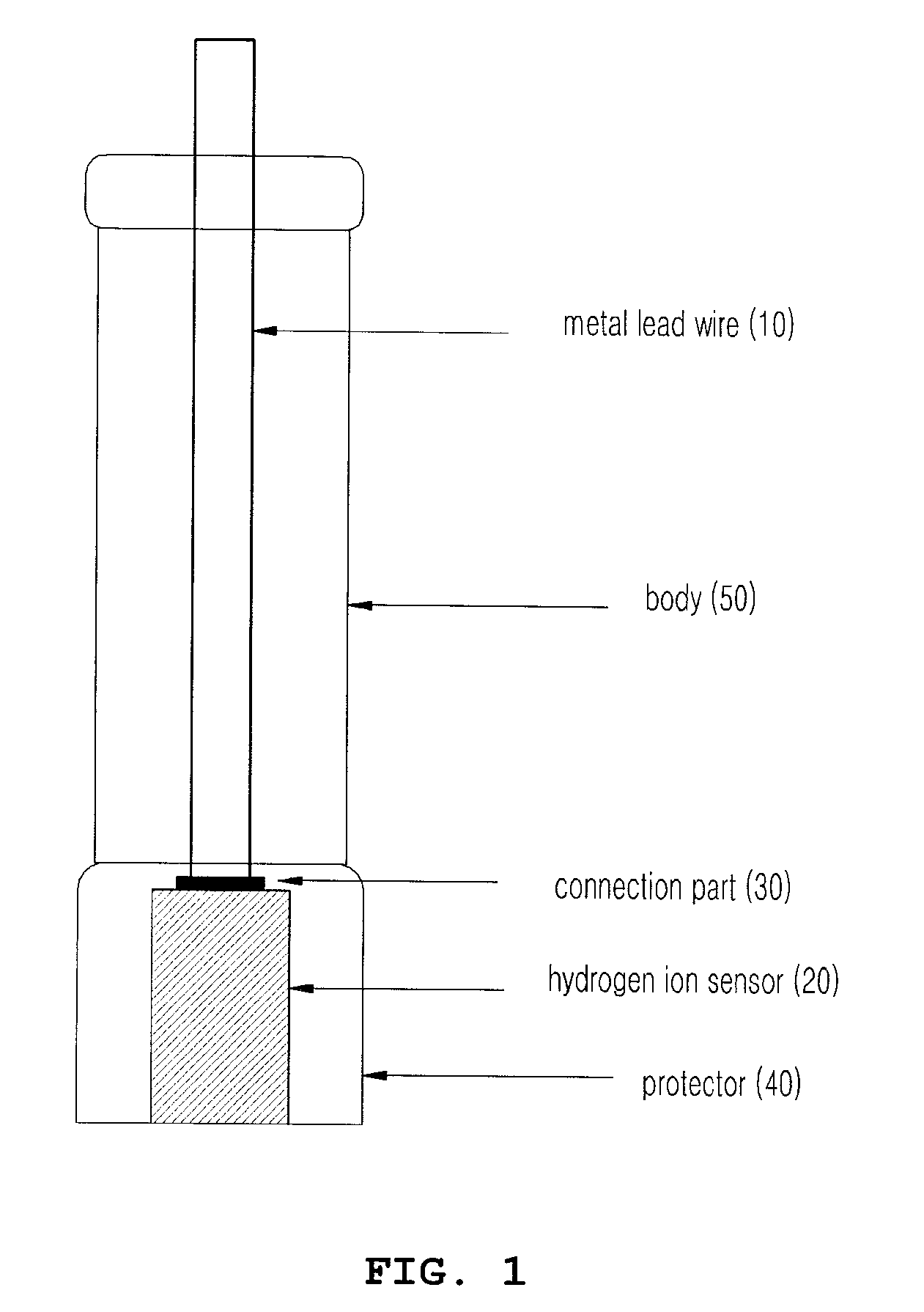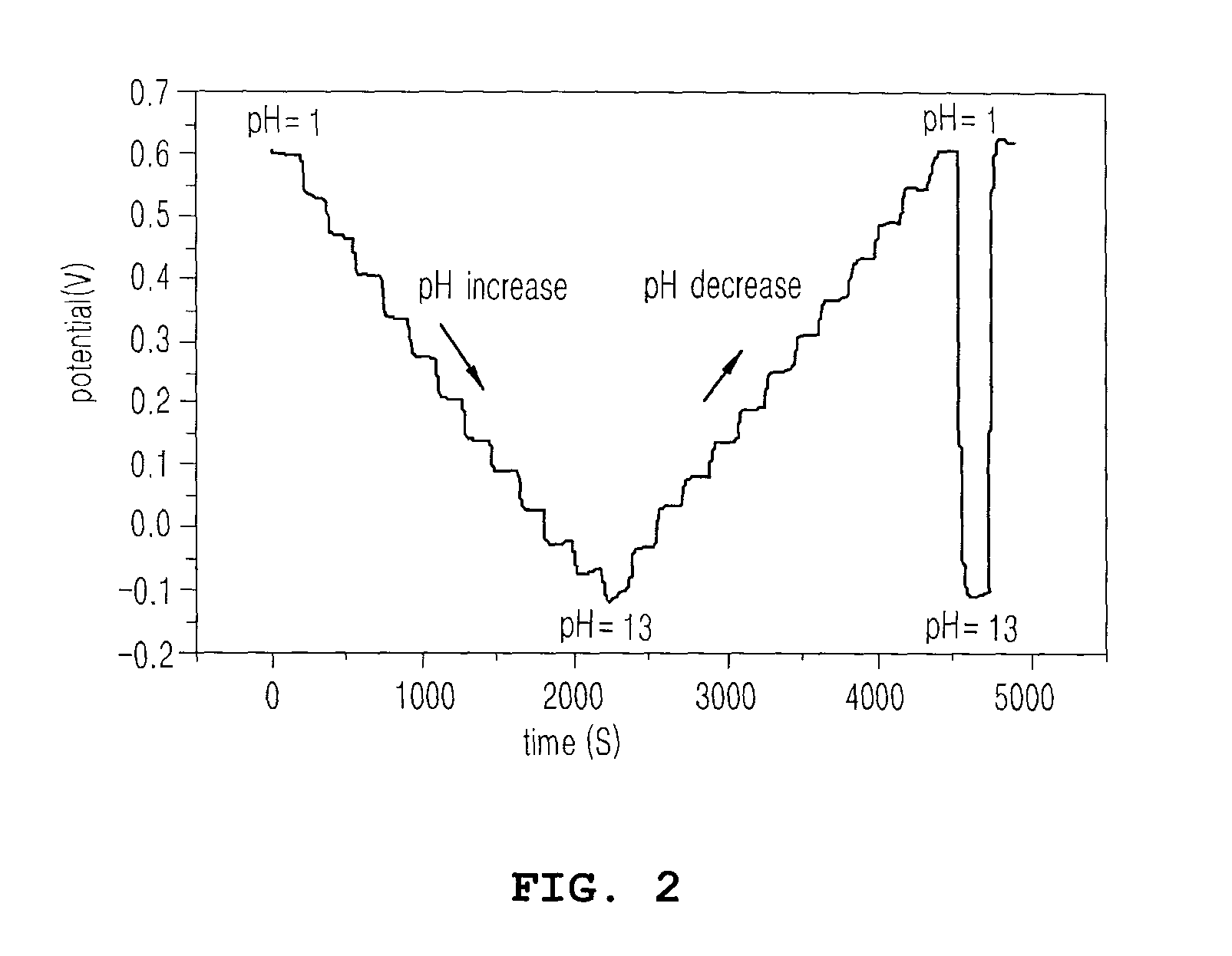Surface renewable iridium oxide-glass or ceramic composite hydrogen ion electrode
a hydrogen ion electrode and composite technology, applied in the direction of electrochemical machining apparatus, natural mineral layered products, conductive materials, etc., can solve the problems of easy breakage, difficult to find effective methods to overcome inactivation and fouling problems, fragile ph glass membrane electrodes, etc., to improve durability and surface renewability, and response characteristics
- Summary
- Abstract
- Description
- Claims
- Application Information
AI Technical Summary
Benefits of technology
Problems solved by technology
Method used
Image
Examples
example 1
Formation of Inactive Conductive Material
[0044]0.5 g of (NH4)2IrCl6 was put in a 200 ml round bottomed flask, and was then dissolved in water by adding 50 ml of water to the flask. Subsequently, 5 ml of ethanol was additionally added to the solution in order to improve the solubility thereof.
[0045]Subsequently, 1.7 g of glass fine powder, having a particle size of 45 μm or less, was added to the flask, and the flask, to which the glass fine powder was added, was installed in a rotary evaporator, and then the solvent present in the flask was evaporated and dried at a temperature of 80° C., thereby coating the glass fine powder with (NH4)2IrCl6.
[0046]Subsequently, the glass powder, coated with (NH4)2IrCl6, was charged in a boat type crucible, and the crucible, containing the glass powder coated with the (NH4)2IrCl6, was installed in a tubular furnace, and then the crucible was heated to a temperature of 500° C. for 5 hours in a hydrogen atmosphere, and thus the (NH4)2IrCl6 applied on ...
example 2
Formation of Iridium Oxide
[0047]0.5 g of (NH4)2IrCl6 was put in a 200 ml flask with a round bottom, and was then dissolved in water by adding 50 ml of water to the flask. Subsequently, 5 ml of ethanol was additionally added to the solution in order to improve the solubility thereof.
[0048]Subsequently, 1.7 g of glass fine powder having a particle size of 45 μm or less, or glass fine powder including iridium metal fine particles formed in Example 1, was added to the flask, and the flask, to which the glass fine powder was added, was installed in a rotary evaporator, and then the solvent present in the flask was evaporated and dried at a temperature of 80° C., thereby coating the glass fine powder with (NH4)2IrCl6.
[0049]Subsequently, the glass powder, coated with (NH4)2IrCl6, was charged in a boat type crucible, and the crucible, containing the glass powder coated with the (NH4)2IrCl6, was installed in a tubular furnace, and then the crucible was heated to a temperature of 500° C. for ...
example 3
Preparation of Composite pH Sensing Material
[0050]The high-temperature sinterable mixture of iridium oxide / glass fine powder or iridium metal / iridium oxide / glass fine powder, formed in Example 2, was molded, and then the molded mixture was sintered at a temperature of 700° C. for 4 hours, thereby preparing a surface renewable iridium oxide / glass composite pH sensing material or a renewable iridium metal / iridium oxide / glass composite pH sensing material.
PUM
| Property | Measurement | Unit |
|---|---|---|
| length | aaaaa | aaaaa |
| temperature | aaaaa | aaaaa |
| temperature | aaaaa | aaaaa |
Abstract
Description
Claims
Application Information
 Login to View More
Login to View More - R&D
- Intellectual Property
- Life Sciences
- Materials
- Tech Scout
- Unparalleled Data Quality
- Higher Quality Content
- 60% Fewer Hallucinations
Browse by: Latest US Patents, China's latest patents, Technical Efficacy Thesaurus, Application Domain, Technology Topic, Popular Technical Reports.
© 2025 PatSnap. All rights reserved.Legal|Privacy policy|Modern Slavery Act Transparency Statement|Sitemap|About US| Contact US: help@patsnap.com



